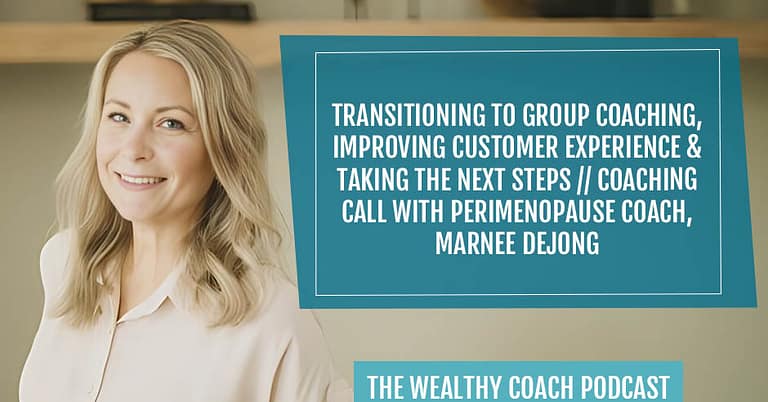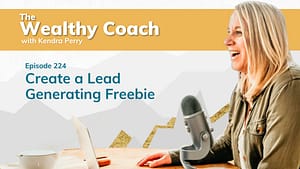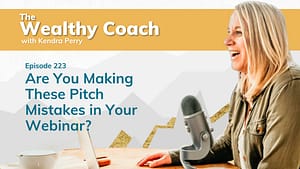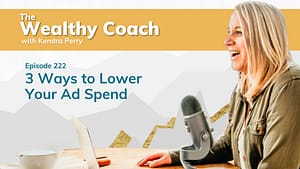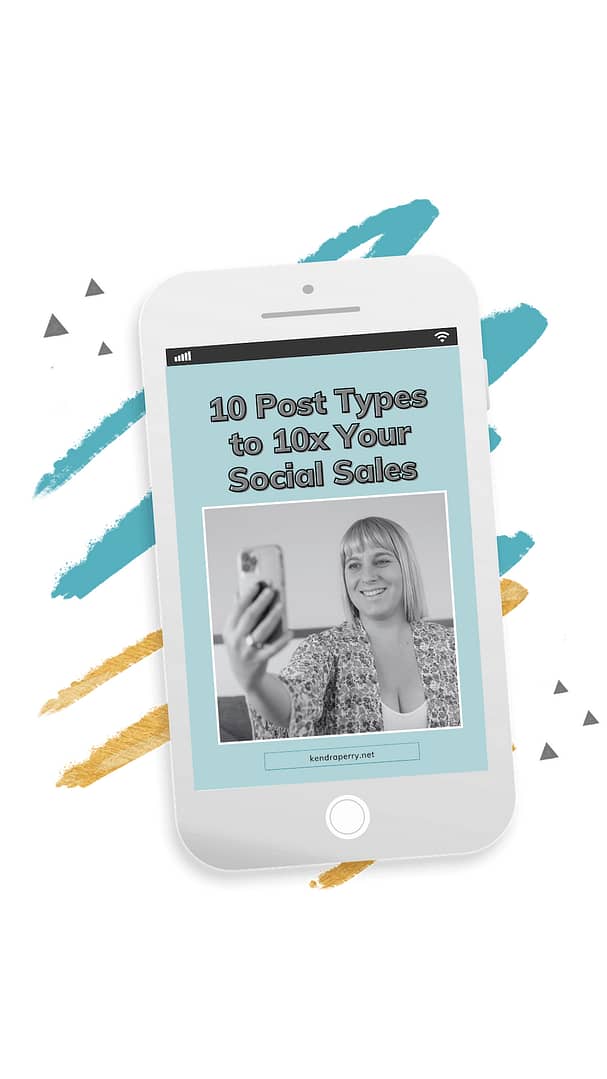Doing one-on-one coaching with your client can be time-consuming, and it only limits the number of clients you can get. But how can you coach multiple clients? In this coaching call with Marnee Dejong, an Integrative Health Practitioner, she learned how to transition to group coaching and improve customer experience. Kendra also touches on paid ads and how they can be inexpensive for the health industry. Further to the conversation, Marnee learned the value of updating her program to provide a better coaching experience for her clients. Gain insights from this coaching call with Marnee today!
Connect with Marnee:
Website: www.marneedejongwellness.com
Instagram: https://instagram.com/marnee.dejong
—
Listen to the podcast here
Transitioning To Group Coaching, Improving Customer Experience & Taking The Next Steps // Coaching Call With Perimenopause Coach, Marnee Dejong
In this episode, we have another interview with one of my Health Coach Accelerator students, Marnee Dejong. She is a perimenopause coach. She came to the HCA in the fall of 2022. She has run about ten clients through her beta program and has now moved into the full version of offering her program. What we focus on in this episode is discussing what the transition looks like from one on one to group coaching so that she can create more freedom and flexibility in her schedule.
We talk about how to improve the client experience and improve her program without the overwhelm and without doing too much. We then talk about a high-level overview of what the next steps look like in her business. There are lots of golden nuggets in this interview. Let’s jump into it. Marnee, can you tell the audience a little bit about who you serve and what you do?
I work mainly with women over 40 in perimenopause. My focus is on hormones, perimenopause, and navigating this season of hormone mayhem. I’m helping women go through this season and helping them focus more on getting back that energy and boosting their metabolism.
When did you start your business?
I finished up my training and jumped into your program and started working with clients.
Let’s dive into the coaching. What did you want to start with about the things we talked about prior to this? What’s the most pressing?
The first thing is I am building out my one-on-one signature program. I love the one-on-one. I have a background as a drug and alcohol counselor. The desire to work one-on-one with clients has been amazing. I love that. However, it is time-consuming. Wanting to work with more clients, I see the need to have a group program. What does that look like? What do I need to know? What are the first steps that I should take to build out a group program if I’m looking to do that in the next six months?
The good news is that you’ve already built out the program. The same program that you’re using for your one-on-one program is essentially the exact same program you’re going to use for your group. You’re just going to hold it in a bit of a different container. Instead of having those one-on-one coaching calls with clients, it’s going to be one group call. You’ll probably do the best way to start out. There are essentially two different routes you can go with a group program. You can run it cohort style, which means there’s a start and an end date. You’re only offering it a few times a year, depending on how long the program is. How long is your one-on-one program?
It’s four months.
You could potentially offer it 4 times or 3 times a year. You can do something that is more of an ongoing enrollment, which is more HCA, where people can enroll at any time. Everyone’s coming in at different points and we have one group coaching call a week. You would first want to make the decision about which model is going to suit your lifestyle more. With a cohort style, it’s typically easier to sell just because there’s true urgency. There’s a start date and an end date. You have to purchase by a certain date or you’re not going to be able to get in because the program will have started. It will be easier to sell, but there’s more pressure on the launch of the whole thing.
You would still want to be doing one-on-one coaching in between because you don’t want not to have anything to offer people. Some people like that. Some people want their one-on-one clients to be their bread and butter and then they want just to run their group program a few times a year. Some people prefer to do that. I did that for a long time. I liked that model. With ongoing enrollment, you have to work a lot harder to sell it because there’s not really true urgency. You can still promote it. You can still have a webinar. You can create urgency around a price discount. You do almost more work to promote it than, but the benefit is that you’re getting sales coming in all the time.
You can make it your only program that way. It just depends because some people want to take summer off, which with an ongoing enrollment, you can’t do until you start bringing other people into the program or other practitioners to help you. With a cohort, you can be like, “I’m going to run this twice a year and then I’m not going to run it in summer. I’m going to reduce my one-on-one client load.” You could create that space in your schedule, whereas it’s harder to do with ongoing enrollment. It’s a preference thing. My preference is the ongoing enrollment because a lot of people want to do a group program, especially for people who want to walk away from the group. That’s going to be the more sustainable model.
You can still take time off. You’re just going to have to have people help you in the program. You’re going to have to get to the point where you’re bringing in other coaches to help out and take over calls and support your students. I have Claudia. I was able to go to Italy. Claudia was able to cover my calls. It is which one resonates with you more. There’s nothing wrong with starting with the live version. Sometimes it’s better to start with the live version to get that better amount of feedback and test it out. You’ve also done a lot of testing with your one-on-one, so you don’t necessarily need to do that. You could go into ongoing enrollment. There are a few different options here.

My initial fear of doing the cohort or the group program, not the ongoing, is if your launch doesn’t go well, then there’s that fear of, “Can I launch again?” if there’s only a small group. The community is so huge. I’m noticing that with the one-on-one, there is a desire for women to have that community, and I see the benefit in that. My initial fear is what if the launch doesn’t go well and I only have a few, and then your Facebook groups and your coaching calls are not much. There’s my fear, and then similar to HCA, the ongoing is also being able to keep track of who is, where, and what I’m also trying to support each client.
A little bit of HCA is people feel motivated to work through the program. There is part of that where they’re working through the program at their own rate. Are they highly motivated and can you coach them to where they need to get to in that four months? I’m used to this high touchpoint and intense one-on-one. It’s feeling like I’m taking a step back. Am I ready to have my clients? I’m involved, but it does look a little different.
It does look different. People will typically be more engaged and more motivated than the live program. Everyone’s in the same place. There’s something about it that’s great, but you could have a launch where you only enroll 1 or 2 people. It happens. There are steps you can take from there. With an ongoing enrollment, the first one, you’re still going to launch it. If you don’t get the people, there’s still an opportunity to keep bringing people in. You’re right. People are more self-paced. They’re working through it, and there is an option for hybrid too. It depends. Some people prefer it because you run labs with clients. Not always, but I’ve run a very low-touch group program with labs involved.
You can still do it. If you want to be more involved in the progress of your people, maybe they get some one-on-one calls, or the best way to do it is to have an upgrade. You buy the group. If you want the one-on-ones, you upgrade for the higher fee because then that allows you to take on a lot more people. If everyone is getting a one-on-one call, you can only take a certain amount of clients at once. You have to manage that, which might be fine for you. Maybe you only ever want to work with 10 to 20 people in your group program at once. If you want to scale and get more freedom, then you might want not to have that or minimize it.
I do the idea of the hybrid. That does resonate with me. I like the fact that you are coming alongside your client. You do have that personal part of the program. You’re helping them through that. I do the community part of it. The hybrid does resonate with me. When you are doing labs and protocols, it is time-consuming. There is that part of it. New to doing protocols, it’s more time-consuming, and I’m learning all that. That is also something that I have to factor in.
This is something you will need to bring someone to help you with. That’s how you’ll scale. You need someone to help you with the protocols, and you can hire someone to do protocols for you. You can create templates like, “When this comes up, we do this. Here’s our protocol,” and you have a little so that they can grab and go. For a while, you’ll probably have to review all of them to make sure they’re good, and then eventually, you’ll trust the person to do the protocol.
It could look like something where they have their initial results call for their lab results. They have a midpoint check-in, and then they have an exit call. It could be as simple as that where you’re not giving them a monthly call or biweekly call, but it’s just they get those check-ins, and then they have the opportunity on group calls to come on and ask questions.
The thing with this is you do have to be organized with your note-taking. It’s easy for people to get lost. The problem with a community that you have to consider is people might be in the Facebook group being, “I took this supplement and I’m getting these symptoms.” You might say, “Stop that and maybe try again later.” You’d want to note that. You’d want to keep track of that so that when you do the protocol in the future, you’re like, “We took this person off of this supplement so we’re not going to recommend it again.” You have to be diligent with your notes, which is fine. You can use practice better or whatever. There are lots of places to keep track of notes, but you do have to be very organized in that way.
What that would essentially look like? Obviously, you need more people to sell to. There’s something I talk about in HCA, which is essentially where you know enough people who might be interested, where you can just reach out to people and say, “Would you be interested?” I would say five. You’d want five to be able to launch a group program. Sometimes we have enough people in our community to reach out and get people in. That’s what I was able to do with my first round.
I just reached out to people who had contacted me about it over the years. They asked and people said yes, and then I just sent out a link. There was no launch. If you’re not in that situation, then you will need to do some formal launch in which you’re going to want to have a certain amount of people on your email list to be able to do that. I would say a few hundred. I usually say a minimum of 300, 500 is probably better, so in the meantime, that’s what you’d want to be focusing on to be able to move ways building that community of email list subscribers.
A little bit of my fear and my block is my email list, which is slowly growing but not as fast as I want. I am building out a new lead magnet. I’m hoping that will help bring in more email subscribers. Probably in the back of my mind is, “I got to get that email list because I do know what’s important. I need to get more people on it.”
You can consider doing something paid ads, which is something that we’re bringing into HCA. I’ve mentioned this to you guys before. It’s inexpensive for the health and wellness industry to advertise, which is nice. An average cost per lead is $1 to $5, which is very low considering the space that I’m in. Potentially, you could build your email list for $1 per subscriber, and that can help it go faster. I’ve seen health and wellness get lower than $1, which is insane, but it’s possible. The nice thing about Facebook ads is you can get ChatGPT to write a lot of your ad copy, and that’s the hardest thing about Facebook ads, which is the copy because you’re testing a lot.
There’s not like, “What’s the best graphic that I should be using?” It’s all about, “I could put a graphic out that converts gangbusters with your audience but falls flat with mine.” It’s just a testing game. That is something to consider, especially if you’re anxious, “I want to get this rolling.” That’s going to be the most predictable way to make that happen. You can do it with regular social media collaborations, which is good, but it’s going to be less predictable.
I’m boosting Instagram posts which are helping, but I haven’t gone into the Facebook ad world yet. That looks different. That’s not just boosting posts. That’s an actual ad strategy.
It’s an ad platform. It’s a little bit more techy. Once you get it, you’ll be good. I was running Facebook ads in 2016 or something like that. I dabbled in them throughout my career. Although the majority of my business never came from that. I learned how to use the ads dashboard in 2016 and then I came back a couple of years ago after 4 or 5 years in there. It’s the same. You learn it once, and it’s the same. The good thing is that AI is a lot more intelligent in finding the right person. It is a bit of a different game in that. You’re attracting cold people, people who don’t know you, like you, or trust you. The conversion to getting them into a client is a bit of a different journey than someone who’s been following you on Instagram.
I do have a business page. It was set up before. I am posting in it to have a presence on Facebook. It is drawing a lot of attention and comments and all that.
That’s smart. It makes your business look active. You’re running Instagram ads, but in the event that you start running Facebook, if people click over to your page, because they will, it shows that you have a business and you’re serious. That’s fine. It’s easy. It’s like you’re reposting the stuff you use on Instagram, which is fine. That would probably be it when you’re asking about what the next steps are once you have everything set up. I don’t know if you remember from the very beginning of the HCA course, but there are these three stages of business.
A lot of what HCA lies in is this testing. We’re in this testing phase where we’re testing and we’re making sure, but you’re starting to move out of that. You’ve been running your beta program. It sounds like your clients are getting results. I know you’re making a lot of changes and updates, but you’re getting to the point where you’re going to have a proven program. It’s this distribution phase. We’ve got a proven offer. We know our target audience, and we’ve got the offer. It’s getting people results. We now can start marketing our business at scale. There are a few different ways you can do that.
There are lots of options you can do. Social media is always a part of it to some degree. If you run ads, you can post less on social media, which is cool. DM conversation is a part of it. It can or cannot be collaborations and ads. Social media is always there, that organic social, but it can’t be the only thing. What is it? Are you going to go heavy on the DMs? Are you going to go heavy into collaborations? Are you going to put all your efforts into Facebook ads? There are lots of options.
If you’re good at one of those things that aren’t organic social media, you can spend very little time on social media. If you want just to market your business on social media without paid ads, then you do have to post a lot. You probably want to be posting at least once every day, maybe even more on stories. You’re just trying to keep it top of mind where, with ads, you can control how many people are going to see your stuff every day.

I’m doing a collaboration or a live Instagram with another hormone coach. She reached out to me. I’m excited about that.
That’s a great thing to do. It cross-pollinates audiences. You can do things whatever you prefer, like pitching guests, blogging, podcasts, whatever that is for you. My big strategy was social media and collaborations. That’s how I grew my entire business. At this point, I’m sick of social media. I don’t want to spend as much time on it. I don’t want to do a lot of collaborations anymore. I like to do the ad summit, but now I’m just putting all my efforts into ads. There are lots of options. There’s not just one way to do things. It depends on how you do things.
The ad thing is appealing because it’s easy, but it’s also money at the beginning of your business. I don’t mind putting a little bit in, but also, you want a return.
The good news is, in health and wellness, you could get away with a budget of $10 a day, which is $300 a month. It’s not that much for advertising, especially if it’s building your list, which is important for the group coaching program. List growth is always important, but it’s less important. If you’re doing one-on-one, you can probably get all your clients from social media and engaging direct messages and outreach like that will work well. Once we’re getting into a group where you need that higher volume, that’s where your list growth becomes important and where you’re going to make all your sales from your email list.
That’s helpful.
It comes down to tracking numbers. You have to track everything. You can track your ROI. You can see that subscriber when they come in, “Do they buy? What’s the average amount of time? It’s six months, cool. Maybe I need a six-month warm-up sequence because it takes them to shorten that up.” It’s about figuring out all your numbers in terms of like, “What’s my average sales call close rate? That means I need to book this many calls a month. How am I going to get those calls booked?”
Now, my thing is, “How do I get in front of more people?” The sales script is golden. I love it. I don’t even mind getting on a sales call. For me, I feel it’s an opportunity to talk with a potential client. You’re serving them. It gets me excited to put it out there, and they’re initiating wanting to talk. They’re interested in something you have. It’s just getting in front and getting more of those calls.
That’s the main goal, get more calls. You want to get in front of more people. In the graduate program, we’re talking about webinars. At some point, you could have a webinar that books those calls for you. The webinar does the qualification process. If they get to the end and they feel they’re a fit, there’s a good chance they are and then they’re booking the call. We can get that set up where it’s a bit more passive. As we talked about, there’s a lot to do and put in place to get there.
It could look like something else too. Maybe you want to do live webinars, or maybe you do workshops. There are so many different ways to do it and nothing is wrong or right. Test it and see how it goes, “Does this align with my lifestyle and how I like to sell? Does this work and get the calls booked?” I’m pretty sure once you get people on the calls and you have that script, you’re going to have a good close rate because the script is gold, like you said.
I’m finding my close rate is pretty good. I just need to get people on the call.
Do you know what it is percentage-wise?
I’ve only had a few people not sign up. That’s encouraging. That’s where I feel there’s probably a little bit of confidence that I know if I can get people on that call, I feel pretty confident in the call.
Would you say it’s probably higher than 50%? Are you closing more people than not?
Yes.
That’s awesome.
That’s where I feel I need to get more calls. That’s where you don’t want to get pushy and try to get salesy.
There’s nothing wrong with being salesy. There’s something wrong with selling something that you don’t believe in or doesn’t work. There’s nothing wrong with inviting someone on a call. The worst that’s going to happen is they’re going to say no and you’re going to say no problem. In two weeks, you’re going to send them your next Instagram post, blog post, podcast, or whatever. You’re going to be, “I did this Instagram live with this one. This might be helpful. Here you go.”
At this point, it is about traffic. We also talked about this on the grad call. If you have an offer that gets people results and you’re making money but not the money you want, we have to look at traffic. I know investing in paid ads can be, “I have to invest.” If you are spending $300 a month and that’s just getting you one client a month at $2,000, I do that all day every day.
That’s helpful.
I know you also wanted to talk about this feeling of the constant need to update your program. Tell me more about that.
I’ve had clients go through my beta, and now I’m working with non-beta clients and learning a ton. There are a lot of learning in the beta phase.
You’re in the full version now, correct?
Yes. I still want to increase my prices.
That’s a journey. You’ll do it.
I am slowly getting there. Yes, it did increase. I’m about to record all my modules. That’s where I’m at. This summer is recording modules, which is interesting because if I do go into a group, should I be focusing on recording modules or can I use those in my group?
You should use the same ones in your group.
I record them as soon as I can.
That would be your next step because that’s going to cut down a lot on your time in session with people.
That’s probably saying the same thing over and over, and the one-on-one has been a lot. That’s where I am. I’ve run through ten clients and you’ve said the same module over. I feel I had that nailed in. There’s been good feedback, and that’s been helpful because I do tweak along the way. I am excited to be able to record the modules, and then I have that time just to do coaching. Doing the modules, all the teaching, plus trying to connect, get feedback, and do the coaching part is a lot in an hour.
You may only need a 30 or 40-minute call. I wouldn’t do hour calls with people because a lot of that time is wasted on small talk. Have a targeted session. That will free up some time in your schedule. You’ve gotten a lot of feedback. Clearly, it’s working. People are liking it, and you’ve gotten positive feedback. I want to do it as soon as possible to record those. It doesn’t have to be video modules. It can be audio. It’s your choice. I prefer audio. I never want to watch video, but it’s up to you. Do what’s easier and if you do need to make updates at that point. There’s nothing wrong with it. I’m always doing the same thing with HCA. I’m constantly thinking about, “How I can make this better? How can I help people get better results?”
It is consuming, but that’s not a bad thing. You don’t have to rerecord everything every time you want to make an update. You can do an addendum. Maybe there’s the recording and addendum or update and watch this little two-minute video where I further clarify this one thing because everyone’s getting confused here. There is, “I’m now doing this.” You can add addendums. I would say once a year, you do a full update. Otherwise, all you’re going to be doing is re-recording and editing. Unless something is so screwed that you’re like, “I need to redo this because this is just not working.” That’s fine. A lot of times, you can do updates, addendums, add on to it, and then do a full update annually.
That’s helpful. It is probably a little bit of pressure to try to get it because you are charging and you want clients to have a good positive experience. Regardless of the cost and what they’re paying, you want them to have a good client experience. I’m always like, “How can it be better? Should I be giving them more or do they need more?” One of the surprises for me is I thought clients would need me more between sessions. I thought clients would need more support. That was a little bit of a surprise to me when I could do my check-in. They responded back, I’d respond back, and that was it.
That was refreshing, too, that clearly, the modules and what I’m giving them were enough. I also have clients that are motivated and hopefully a good fit for my program. That’s where I feel if I’m giving them a level of learning and support in these modules, I should be okay to roll them into a group program. That’s my thoughts. Also, I do feel the need to be constantly be, “How do I make it better? Do they need support? So-and-so struggled at this part. Maybe they need this and this.” It is that constant feeling of, “How do I make the client experience better?”
That’s important. It is something that we should always be working on. I agree. Your line of thinking is correct, “They do not need me a lot.” This could be a group. They are going to have less access to it, and that’s a good thing. Does it bother you at all that people don’t need you as much as you thought? Is there any internal thought pattern around that? I’m curious.
Coming from a counseling background, it was one-on-one. I thought maybe it would be more of a back-and-forth. That’s not a bad thing. It wasn’t like, “How dare they not need me.” You’re like, “I thought it would look a little different, but it wasn’t a bad thing.” It was a little bit of reframing of they don’t need to be needing me all the time. I’m checking in, giving them support and accountability. It was reframing that a little bit
When you find yourself trying to improve the experience, how are you doing that? I’m trying to differentiate if you’re improving experience versus maybe going through boundaries and giving too much.
I feel that’s a little bit of me trying to figure out they don’t need access to me all the time. I can have boundaries of, “Have I gone on Voxer after 5:00? Yes.” That’s me learning a little bit of it can wait or they’re okay. There’s a little bit of that learning that they don’t need me, and I don’t need to be immediate. There has been a little bit of learning about that, but there has also been feedback where some clients have said, “I don’t want to eat eggs for breakfast every morning. I don’t know how to get my protein.”
That was good feedback and I was like, “Let’s put a protein guide.” Clients liked that. Those are the feedbacks that have been good. I also had one client that was struggling and wanted to lose weight. I go to that place of, “What do I need to do for this client because the number’s not moving? They’re frustrated.” Not internalizing that has been an interesting process of not taking that personally or internally of, “Is this working right?” and how to work through that with your client.
With your demographic, you are going to have people who want to lose weight, and you’re going to have people where the scale doesn’t budge because that’s a hard time losing weight. I don’t think what you’re doing is wrong because you’re creating these guides. You’ve created it. You have that protein guide. You don’t have to do that again. You’ve got that. It’s evergreen. I don’t think there’s anything wrong with that.
You are at a time in your business when you are going to be spending more time on improving the program. There’s nothing wrong with that. Looking at this client whose scale won’t budge, knowing that this is going to come up again, is there a bonus or an extra add-on thing that’s optional like, “These are my best tips if the scale won’t budge. Here are some strategies you can try.” You also talk about sometimes it doesn’t budge until you get your gut cleaned up and whatever.
I’m still building out. It feels time-consuming and all-consuming at times. That’s where I am in my business. I’m trying to take a step back and realize, “I’m building. I’m setting foundations and this is time-consuming, but there will be a time.” I do know my modules, my PDFs, and some guides are put in place. I know that will help in the future to let up some time.
Take note of that because if you come up with a resource that helps this one client with weight, then you’ve got that. You’re good. You don’t need to go down that road anymore. You will always still, as a coach who wants, “I care deeply about my students.” I don’t just update once a year. I’m throwing in updates as I see needed and see fit. You will be doing it less. I want to come back because this is probably why you’re feeling a bit overwhelmed. You’re spending a lot of time updating the program, but then you’re also like, I need to get in front of more people. Is that true?
Yes.
Do you have anyone helping you?
No.
I would say that because you’re making some money from your business. It doesn’t have to cost a lot to outsource. What is something that you spend your time on where you feel you’re banging your head against the wall where you’re like, “I hate this?” What is that?
It is feeling you’re nailing your content. There’s that pressure and your presence on Instagram, constantly feeling like, “I got to get into my stories. I got to be posting consistently.” There’s probably part of that, but then there’s also the communication with clients. I have automated my onboarding, and that’s pretty decent, but there are certain things that I feel I’m spending a lot of time admin or the little things that I’m like, “That would be nice to get off my plate.”
It sounds like it would probably be helpful for you to have someone helping in some way with content, even if that’s just to schedule it or create a quick design. It also makes you more consistent when this person needs your content for June or May 15th every month, “I got to get this content to them.” That can help make you more consistent. It sounds like you need some help with admin. You support your clients, but sometimes they need help with onboarding. They need help with lab sample collection. Someone could be in your inbox helping you with that.
It’s all the little things. I am sending off labs. I have one client that two of their HTMAs got lost in the mail somehow and now I’m sending a third. It’s stuff like that. Those are things that are going to happen. It is what it is, but it is time-consuming, and things I’m constantly like, “Did you get your kit?” You’re communicating and then you get the results and you’re building out the protocol for supplements. That’s the thing. It’s learning all the things. It is getting clients supplements, then they order through me and then I have to ship to them. Those are things that are time-consuming.
Also, that someone else could do. You don’t need to be doing those. That will take the most time off your plate. It doesn’t have to be expensive. You’d be looking for a virtual assistant, someone who does admin. You’d want someone who would work within your time zone. They don’t necessarily have to live in North America, but they’d want to be able to work because you’re going to want to be able to communicate back and forth with them. My first virtual assistant was $7 an hour. They were doing three hours a week for me. It’s not a lot of money for the amount of time it can give back to you.

I will consider that.
It can help you with your job posting and that sort of thing. You could find someone, even if it’s just to deal with the lab and supplement stuff. You could start with that. You deal with the shipping of the lab and supplement stuff.
That would be helpful. With little things off your plate, then you can focus on the client experience, your clients, and even the social media part, then you can focus on getting in front of your clients.
You’re at a good place in your business to do it because you’re through beta. Your program is proven. It gets people results. You’re making money. You’re upping your prices. At some point, you’re going to start getting busy. Probably within the next year, you’re going to start getting busier and busier. It would be better to bring someone on when you’re not as busy versus what I did, and I brought someone on at the height of my busyness.
It was super because when you bring someone on, it creates more work because you have to train them. You have to create the processes and make sure your company manual for those processes is updated because they need to know exactly how you want them to interact with people, all the processes for ordering the supplements, and what to do if something goes wrong here. That takes time. It will create more work for you initially. It’s a good time to do it. You could start small. I just need someone to order the supplements and deal with the lab stuff.
That’s true. Start small.
That would maybe be an hour a week, perhaps, or two hours a week at first wouldn’t be much. Anything else that you need support with?
I want to ask you a question. From your experience, what do you think are the top three things that make a health coach make it get to those 10k months? If you were to say three things that you’ve seen from your experience, what are the three things that you see?
I love that question. I honestly think most of them are mindset related. I believe in persistence, self-belief, and resilience. Those are the three things because the marketing, the strategy stuff, it’s executing. It’s doing it. There are ups and downs. Sometimes you doubt yourself. Sometimes you lose confidence. You get rejected. Sometimes it doesn’t feel good. Sometimes someone says something mean to you on social media or whatever. When I look back and it’s like, “Why did I make it?” I was super persistent. I was stubborn. I was like, “Nope, I’m going to do this.” I didn’t have a backup plan.
I just decided I was going to make it work. I had a belief that I could do it. I developed a lot of resilience. Do things happen that set me back or make me want to give up on my business? All the time, but you develop that resilience to the point where you’re like, “This upset me. This was a setback. I’m going to have my emotions and feelings about it. Tomorrow, I’m going to get back to it.” It’s more about that than any specific strategy or social media ads. All of it can work. It’s more just about the mindset around it. That’s what makes or breaks it. Does that help?
Yes, I like it. I wanted to know what it was.
That’s what I’ve seen in students who come through HCA because people come in very early stages. There are people who come into HCA who don’t even know what online business is. It’s not offline, where you can just set up a storefront and hang out. It requires you to be putting yourself out there constantly. It is mostly mindset. You have to want to do that. Not everyone’s built for it. You are, 100%. I have no worries about you. You already have made it, in my opinion.

I’m determined. I’m a little bit stubborn, and I am in for the long haul.
That’s what it has to be. It’s not like, “I’m just going to test this out.” It’s like, “No, this is my job now.” You rise to the top in a job. You’re persistent. You believe you can do it, you keep going, and that’s how you get to the top of a corporate job. It’s the same thing in business. It just looks different. Thank you so much for doing this with me. This has been fun.
This is great.
Thank you, everyone, for reading. I hope you enjoyed this episode. As always, I will see you next episode, same time, same place, and we’ll help you become wealthy AF.
Important Links
About Marnee Dejong


